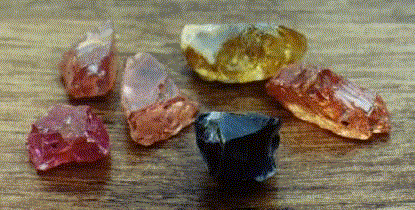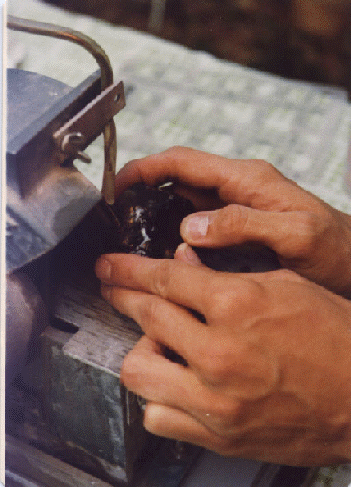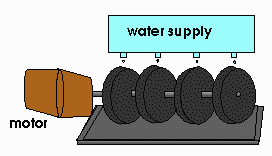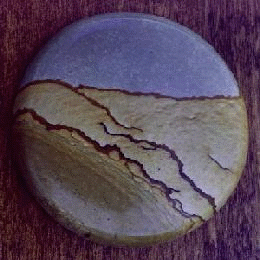 Rough corundum.
Rough corundum.
Not required for EPS2 students
The process of cutting and polishing gems is called gemcutting or lapidary, while a person who cuts and polishes gems is called a gemcutter or a lapidary (sometimes lapidarist).
Gemstone material that has not been extensively cut and polished is referred to generally as rough. Rough material that has been lightly hammered to knock off brittle, fractured material is said to have been cobbed.
 Rough corundum.
Rough corundum.
All gems are cut and polished by progressive abrasion using finer and finer grits of harder substances. Diamond, the hardest naturally occurring substance, has a Mohs hardness of 10 and is used as an abrasive to cut and polish a wide variety of materials, including diamond itself. Silicon carbide, a manmade compound of silicon and carbon with a Mohs hardness of 9.5, is also widely used for cutting softer gemstones. Other compounds, such as cerium oxide, tin oxide, chromium oxide, and aluminum oxide, are frequently used in polishing gemstones.
Several common techniques are used in lapidary work:
 Sawing a piece smoky quartz. (Warning! Holding rough by hand
during sawing can be hazardous to the stone, the saw, and the cutter!
Extreme caution is required.)
Sawing a piece smoky quartz. (Warning! Holding rough by hand
during sawing can be hazardous to the stone, the saw, and the cutter!
Extreme caution is required.)
In most gem sawing, a thin circular blade usually composed of steel, copper, or a phosphor bronze alloy impregnated along the outer edge with diamond grit and rotating at several thousand surface feet per minute literally scratches its way through a gemstone. A liquid such as oil or water is used to wash away cutting debris and keep the stone and the sawblade from overheating, which could cause damage to both the stone and the sawblade.
Several sizes of circular rock saws are frequently used by most gemcutters:
There are also jigsaws that employ either a reciprocating wire or a continuous thin metal band. These are useful for cutting curved lines that are impossible with circular saws. They are also useful in minimizing waste on extremely valuable rough material.

Grinding, usually with silicon carbide wheels or diamond-impregnated wheels, is used to shape gemstones to a desired rough form, called a preform. As with sawing, a coolant/lubricant (water or oil) is used to remove debris and prevent overheating. Very coarse diamond or silicon carbide, such as 60 grit, or mesh, (400 micron particles) or 100 grit (150 micron particles) is used for rapid removal of stone, and finer abrasive (600 grit - 30 micron, or 1200 grit - 15 micron) is used for final shaping and sanding.
Sanding is similar to grinding but uses finer abrasives. Its purpose is to remove deep scratches left by coarser abrasives during grinding. Since it removes material less rapidly, it also allows more delicate control over final shaping of the stone prior to polishing. For stones with rounded surfaces, a flexible surface such as a belt sander is often used to avoid creating flat areas and promote smooth curves.
Lapping is very similar to grinding and sanding, except that it is performed on one side of a rotating or vibrating flat disk known as a lap, and it is used especially to create flat surfaces on a stone (as in faceting). Laps are often made of cast iron, steel, or a copper-bronze alloy, but other materials can also be used.
After a gemstone is sawed and ground to the desired shape and sanded to remove rough marks left by coarser grits, it is usually polished to a mirror-like finish to aid light reflection from the surface of the stone (or refraction through the stone, in the case of transparent materials). Very fine grades of diamond (50,000 to 100,000 mesh) can be used to polish a wide variety of materials, but other polishing agents work well in many instances. Usually, these polishing agents are metal oxides such as aluminum oxide (alumina), cerium oxide, tin oxide, chromium oxide, ferric oxide (jeweler's rouge), or silicon dioxide (tripoli). Different stones are often very inconsistent in their ease of polishing, particularly in the case of faceted stones, so gemcutters are often very inventive in trying new combinations of polishing agents and polishing surfaces -- often tin, tin-lead, lead, leather, felt, pellon, wood, or lucite laps for flat surfaces such as facets. Rounded surfaces, such as on cabochons, are often polished on felt, leather, cork, cloth, or wood. Polishing removes small quantities of stone and can be used, especially when faceting small stones, to do ultrafine shaping of the stone.
When a gemcutter desires a hole in or through a gemstone (e.g., a bead), a small rotating rod or tube with a diamond tip, or a slurry of silicon carbide and coolant, is used to drill through the stone. Ultrasonic, or vibrating, drills are also very effective, but they tend to be costly and thus reserved for high-volume commercial drilling.
Large quantities of roughly shaped stones are often tumbled, i.e., turned at a slow speed in a rotating barrel with abrasives and water for extended periods (days or weeks). By tumbling with progressively finer grades of abrasive (usually silicon carbide) and washing carefully between grades, the stones are gradually smoothed and polished to serendipitous but often very attractive shapes. Tumbling barrels are often hexagonal in outline in order to enhance the stirring action of barrel rotation. An alternative to rotatory tumblers is a vibratory machine, often called a vibratory tumbler, in which the containing barrel vibrates rather than rotates. The more stationary arrangement of vibratory machines makes it much easier to examine the progress of the stones inside, whereas standard tumblers must be halted in order to check progress. In addition to polishing gemstones, tumbling is often used to polish large quantities of metal jewelry.
 One of the simplest lapidary forms is the cabochon, a stone that
is smoothly rounded and polished on top, relatively flattish,
and either flat or slightly rounded on the bottom (which may be
either polished or sanded). This form of cutting is often used
for opaque or translucent stones, but is also frequently used
for transparent materials that contain too many inclusions to
yield a good faceted stone. Coloration and patterning provide
the major interest in such stones. Cabochon cutting, or cabbing,
is often performed by simply holding the stone in the fingers,
but it is more commonly done by dopping (attaching with adhesive
wax or glue) the stone to a wooden or metal dopstick. This facilitates
twirling the stone to form smooth curves and avoid flat areas
during grinding, sanding, and polishing. A typical cabbing machine
holds several wheels representing a progressive series of diamond
or silicon carbide grit, turned by a common arbor and motor, and
a water supply that provides a coolant/lubricant to wash away
debris and keep the stone from overheating as it is ground and
sanded on progressively finer wheels.
One of the simplest lapidary forms is the cabochon, a stone that
is smoothly rounded and polished on top, relatively flattish,
and either flat or slightly rounded on the bottom (which may be
either polished or sanded). This form of cutting is often used
for opaque or translucent stones, but is also frequently used
for transparent materials that contain too many inclusions to
yield a good faceted stone. Coloration and patterning provide
the major interest in such stones. Cabochon cutting, or cabbing,
is often performed by simply holding the stone in the fingers,
but it is more commonly done by dopping (attaching with adhesive
wax or glue) the stone to a wooden or metal dopstick. This facilitates
twirling the stone to form smooth curves and avoid flat areas
during grinding, sanding, and polishing. A typical cabbing machine
holds several wheels representing a progressive series of diamond
or silicon carbide grit, turned by a common arbor and motor, and
a water supply that provides a coolant/lubricant to wash away
debris and keep the stone from overheating as it is ground and
sanded on progressively finer wheels.
 Faceting is most often done on transparent stones. Flat facets
are cut and polished over the entire surface of the stone, usually
in a highly symmetrical pattern. The stone is dopped (usually
with adhesive wax, epoxy, or cyanoacrylate glue) on a metal dopstick,
which is then inserted in a handpiece that allows precise control
of positioning. The cutting angle is adjusted vertically via a
protractor and rotationally via an index gear. The
facets are then ground, sanded, and polished on a rotating lap,
while water or another liquid acts as a coolant and lubricant.
When one side (top or bottom) of the stone is finished, a jig
is used to transfer to the stone to a dopstick on the opposing
side.
Faceting is most often done on transparent stones. Flat facets
are cut and polished over the entire surface of the stone, usually
in a highly symmetrical pattern. The stone is dopped (usually
with adhesive wax, epoxy, or cyanoacrylate glue) on a metal dopstick,
which is then inserted in a handpiece that allows precise control
of positioning. The cutting angle is adjusted vertically via a
protractor and rotationally via an index gear. The
facets are then ground, sanded, and polished on a rotating lap,
while water or another liquid acts as a coolant and lubricant.
When one side (top or bottom) of the stone is finished, a jig
is used to transfer to the stone to a dopstick on the opposing
side.
A faceting machine usually employs a motor that turns a lap, a water supply, an adjustable handpiece with index gears and a protractor, and an adjustable mast or platform to hold the handpiece assembly. Most commercially available gemcutting machines employ a mast, but a few employ a platform.


In recent years, innovative faceters have employed techniques such as concave facets, grooves, and combinations of faceting and cabbing to produce new forms in faceted stones.
Spheres are initially sawed into cubes or dodecahedrons and then ground to shape between two pipes or rotating concave cutters, allowing the stone to rotate freely in any direction to form a perfect spherical shape. As with other lapidary processes, gradually finer grades of abrasive are used to grind, sand, and polish the stone. While beads may be faceted, they are more commonly cut and polished as small spheres and then drilled to allow stringing. Bead mills are used to grind and sand large quantities of beads simultaneously. They typically employ a grooved lap and a flat lap between which the beads are rolled and worn to shape. After shaping and sanding, beads are usually polished by tumbling .
In an inlay, a gemstone is cut to fit and glued into a hollow recess in another material (metal, wood, or other stones) and then the top ground and polished flush with the surrounding material. Stones most commonly used for inlay are strongly colored opaque stones such as black onyx, lapis lazuli, turquoise, tigereye, etc.
In both intarsia and mosaic work, small bits of different colored stones are fit together and the top cut and polished to present a picture or other interesting pattern. Strictly speaking, a mosaic is constructed on top of a flat base of another material (usually stone), while an intarsia (also known as Florentine mosaic, or pietre dure) is set flush into the surface of the base material. The finest intarsias and mosaics were traditionally of Italian origin, but intarsia has enjoyed something of a renaissance in recent years with the fine work of artists such as Jim Kaufmann and Nicolai Medvedev.
Cameos and intaglios are similar in that both usually are carved portraits in stone or seashells. They differ in that cameos are raised portraits, while intaglios are carved down into the surface of the material. Both typically take advantage of different colored layers of material. The finest cameos and intaglios have traditionally come from Italy (usually shell) or Germany (usually agate).
Gemstones can be carved, like other materials, into almost any form, limited only by the talents of the sculptor. Carving is accomplished with a variety of diamond-impregnated steel bits, saws, and grindstones.
Note: the information in this html page has been downloaded with permission from John Miller's excellent gems site.